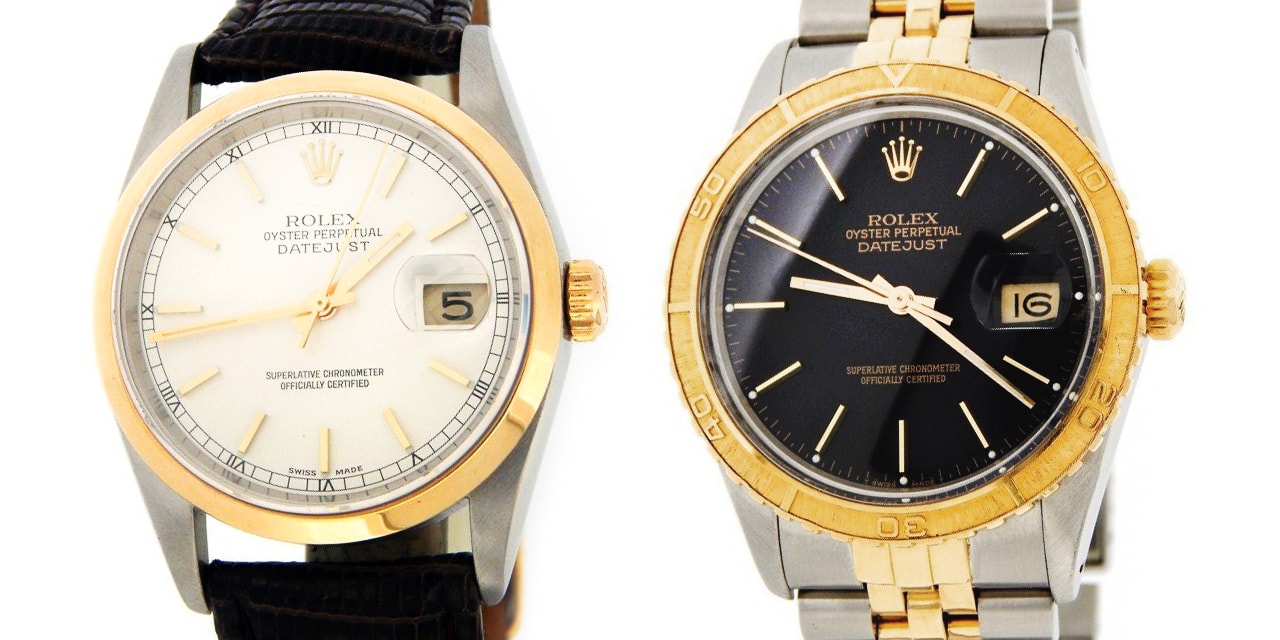Two Tone Rolex Datejust Compare: 16003, 16013, 16253 vs. 16203, 16233, 16263
Over 70 years since its launch, the Rolex Datejust continues to be the flagship model of the brand. While the Datejust is instantly recognizable thanks to its strong design codes, it is also the most diverse Rolex collections out there with a host of material, dial, bezel, and bracelet options. Even when you take a specific style, such as the two tone Rolex Datejust, there are still so many style options to comb through. Today, we compare two tone Datejust models 16003, 16013, 16253 vs. 16203, 16233, 16263. Two very different generations of the Datejust models.
The Essentials of the Two Tone Datejust
Although we’re here to compare two tone Datejust differences between the two eras, we first must mention what the similarities are across all Datejust watches. Every watch that we’re touching upon today includes a 36mm Oyster case built to be water resistant to 100 meters. Also, since today’s topic is the two tone Datejust, each of these Rolex watches combine rugged stainless steel and precious yellow gold. In Rolex-speak, this marrying of two metals is called Rolesor. “Datejust” takes its name from the date window that you’ll always find at the 3 o’clock position, along with its loyal Cyclops magnification lens companion sitting directly on top of it. Lastly, all two tone Datejust watches highlighted today run on automatic mechanical movements.
Design: Two Tone Rolex Datejust 16003, 16013, 16253 vs. 16203, 16233, 16263
The two tone Rolex Datejust ref. 16003 and ref. 16203 have yellow gold smooth (domed) bezels. The ref. 16013 and ref. 16233 have yellow gold fluted bezels. And, the ref. 16253 and ref. 16263 have yellow gold engine-turned “Turn-O-Graph” rotating bezels.
Rolex began production of the two tone Datejust ref. 16003, ref. 16013, and ref. 16253 in the late 1970s and continued for about a decade until the late 1980s. As with other Datejust watches from the era, the two-tone Datejust ref. 16003, ref. 16013, and ref. 16253 watches have acrylic crystals, tritium lume, and lug holes on the cases. These models either came with two tone Oyster or Jubilee bracelets with hollow links, end pieces, and flip clasps.
Rolex replaced this generation with the new two tone Datejust ref. 16203, 16233, and 16263 in the late 1980s. A big change of the newer two tone Datejust models was the use of scratch-resistant sapphire crystals rather than acrylic ones.
Rolex produced the Datejust ref. 16203, 16233, and 16263 until the mid 2000s. During that time, they made several design modifications to the models. For instance, in the mid 1990s, Rolex stopped including lug holes in their cases. So early models from this generation have lug holes, while those examples that came after the mid 1990s do not have them.
Similarly, Rolex began using Luminova in the late 1990s followed by SuperLuminova a few years later for dial luminescence. So, depending on when it was manufactured, it’s possible to have two tone Datejust ref. 16203, 16233, and 16263 watches with either tritium, Luminova, or SuperLuminova lume.
The bracelets, however, didn’t change during the production period and all two tone Datejust ref. 16203, 16233, and 16263 watches were offered with either Oyster or Jubilee bracelets with flip clasps and hollow links.
Movement: Two Tone Rolex Datejust 16003, 16013, 16253 vs. 16203, 16233, 16263
Powering the two tone Datejust 16003, ref. 16013, and ref. 16253 watches is Caliber 3035, while the two tone Datejust 16203, 16233, and 16263 run on Caliber 3135. Although both are automatic mechanical movements with quickset date function where the date window is set independently from the hour and minute hands, there are a few differences.
Caliber 3135 boasts enhancements in accuracy and robustness, in addition to a slightly increased power reserve of 48 hours compared to the Caliber 3035’s 42-hour power reserve. A way to distinguish the Caliber 3035 from the Caliber 3135 without opening the case is by noticing you set the time. To adjust the time with Caliber 3035, the winding crown turns counterclockwise, whereas with Caliber 3135, the winding crown turns clockwise.
To sum up, when we compare two tone Datejust models between these two eras, the older Datejust ref. 16003, ref. 16013, and ref. 16253 offer a decidedly more vintage vibe. On the other hand, the newer Datejust ref. 16203, ref. 16233, and ref. 16263 watches include more modern features, but also have the option for vintage touches when looking earlier examples.
— Featured and Body Photo Credits: BeckerTime’s Archive.





